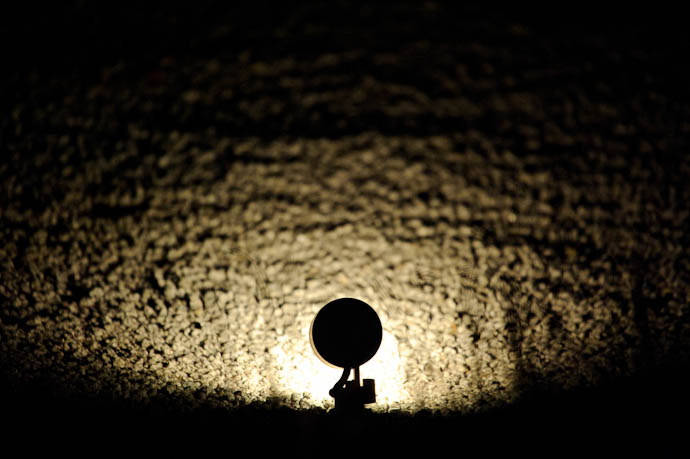
Nikon D700 + Sigma “Bigma” 50-500mm OS @ 500 mm — 1/125 sec handheld, f/6.3, ISO 6400 — map & image data — nearby photos
Mysterious?
I gave my new Sigma “Bigma” 50-500mm superzoom a shot in the dark (so to speak) yesterday evening, and while looking through the results today, came across this throw-away shot of a spotlight at a rock garden. The photo is wholly unremarkable except for some very weird indistinct wavy parallel tracks that can be seen in the full-resolution version, as if snails had been sledding over the rocks.
But it's not sledding snails. Can you explain the wavy lines?
As always with my quizzes, I will not make submitted answers publicly visible for the first day or three, to give everyone a shot at answering without being influenced by others' answers.
(The high-resolution version was exported from Lightroom in its raw “as imported” state, without any post processing. Normally on a shot like this my post processing would consist of the 'x' key (delete), but on a shot like this that was worth saving, I'd normally add some luminance noise reduction, because the D700's low-light ability at ISO6400 is good, but not that good.)
My guess would be that it has something to do with heat from the lamp, disturbing the air density and creating distortion of the light.
The lamp itself would perhaps be a halogen lamp. Its oscillations would be causing the repeating lines that would otherwise be just one line?
But I am a bit baffled by the fact that the lamp would have something like 35kHz, your shutter speed was 1/125 and I count seven lines, that leaves about 40 times less lines than should be there. Maybe a factor also of the sensor?
Or maybe something else entirely. 🙂
Heat waves maybe as the sensor reads the info coming through the lens. I seem to get these wavy lines from time to time here in Tucson , AZ while shooting my D40.
That’s the best I can tell, probably not correct but Its a shot in the dark ( no pun intended)
I think they might be signs of heat waves radiating from the spotlight.
I’m guessing everyone will go with heat waves from the light. I’m going with grass/vegetation that’s very close to you and out of focus… Although it looks like heat waves from the light! 😉
I guess it’s a word/sentence “written” on the rocks?
(Nice lens review btw, would you recommend it for someone looking for a supplementary lens above Nikkor 70-200 2.8?)
Regards from Belgium!
You are looking at two masses of air that differ in refractive index as the air around the spotlight is warmer than the air further away from the spotlight. Refractive index gradients are formed in the air and they cause bending of the light rays in the direction of increasing refractive index. This effect create alternating light and dark waves. This is similar to Schlieren photography that uses a knife edge to block some of the light rays and separate a fluid or a gas by a refractive gradient and this allows the observation of varied flow dynamics.
Fernando
Fingerprint on the lens?
Mirage! … Does this sound funny ;-)?
Diffraction
My guess is that its schlieren, right? Same thing as when you look at the hot air over a barbeque grill, hot car, or hot road. “I could see the heat coming off the road…” -that kinda’ thing.
It may be the dispersion of light caused by the sets of angled ribs on the glass refractor of the light source.
Out of focus cables???
I would think it’s an out of focus object, probably some blades of grass.
I’ve posted the answer here. —Jeffrey
It’s the effect of the optical image stabilizer (or vibration reduction for Nikon)